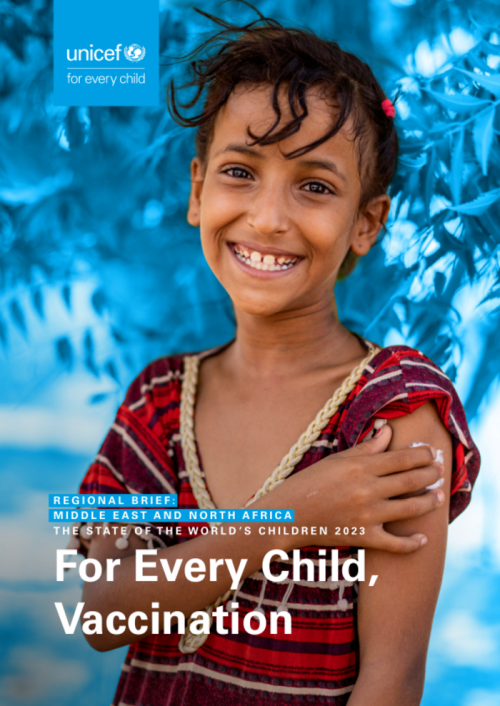
https://www.unicef.org/reports/state-worlds-children-2023
Highlights
https://www.unicef.org/reports/state-worlds-children-2023#Reportarea
The world is facing a red alert for children’s health: Routine vaccination coverage dropped sharply during the COVID-19 pandemic. UNICEF’s latest report, The State of the World’s Children 2023: For every child, vaccination, explores the reasons behind this red alert and the steps we as a global community must take to make sure that no child is left behind.
The pandemic placed unprecedented demands on global health systems. To try and cope with the crisis, a lot of health systems were forced to divert scarce resources away from providing routine care, which includes immunization efforts.
The demands that were placed on health workers were extraordinary. As well as being expected to handle a huge increase in their workload, many workers were also coping with additional burdens at home, including caring for their own families. At work, many could not access essential equipment, including personal protective gear. These health workers also faced the risk of infection as well as social discrimination and attacks. Therefore, burn-out became a critical issue that had a profound impact on immunization campaigns. Meanwhile, stay-at-home recommendations had a significant impact on families’ ability and willingness to access health facilities and get their children vaccinated.

Most zero-dose children live in the poorest and most marginalized parts of the world, where historically primary health care systems have been ill-equipped to reach these children. The health systems operate with limited resources and suffer from a lack of skilled health workers. And for those health workers who do work in these communities, they often have limited access to vaccines and the supplies that are needed to administer them. Additionally, data collection in these communities is often very challenging and limited, so monitoring where under-immunized children live and reaching them with vaccination campaigns becomes extremely complicated.
Poverty has a profound impact on whether a child has access to vaccines. Many of the growing number of zero-dose and under-vaccinated children live in settings where they face significant economic barriers. Globally, in the poorest households, just over 1 in 5 children are zero dose; in the wealthiest, it is 1 in 20. These zero-dose and under-vaccinated children often live in remote rural areas and urban slums.
In remote communities, health services are often scarce, and families live far away from health facilities. Supply chain issues, shortages of health workers and a lack of electricity, water and sanitation are all significant barriers to the availability of vaccines.
In urban slums, health care systems are often ill equipped to meet the needs of large populations and affordability is a serious barrier. Parents and caregivers who juggle multiple jobs and responsibilities often can’t afford to take time away from work and pay for the transportation needed to reach health facilities, as that has a significant impact on a family’s financial bottom line.

Instability and violence – the hallmarks of conflict – are significantly hindering children’s opportunities to be immunized. In 2018, 40 per cent of the world’s zero-dose children lived in fragile or conflict-affected settings.
Reaching children with health services in these settings is very challenging. Health workers themselves are often displaced, financing for health services is halted and vaccine supply chains are disrupted. Health facilities are also sometimes targeted, making it dangerous for families to access care.
Meanwhile, in recent years, conflict has forced millions of children to flee their homes and migrate to camps for refugees or internally displaced people. Given that families in these settings are often transient, it’s much harder to monitor vaccination rates among these communities and reach children with the life-saving vaccines they need.
The decision to vaccinate a child depends in part on trust. A parent or caregiver must have faith in the health care system, vaccine producers and government health institutions. Even before the COVID-19 pandemic, vaccine hesitancy was identified as one of the top 10 threats to global health.
There are now worrying signs that in many countries we’re witnessing significant declines in vaccine confidence, with growing access to misleading information on social media contributing to this trend. And in some parts of the world, there’s declining trust in the authorities that are responsible for carrying out vaccination campaigns. All those factors are contributing to the backslide.
As health workers, women are often on the frontline, administering vaccines to the children that need them most. But in most parts of the world, they’re often low-paid and denied opportunities for training and professional growth. Although women form the bulk of the health workforce, they have long been underrepresented in leadership roles. Part of the reason behind the inequity in pay in the health care sector is that many women serve in unpaid and underpaid roles, typically as community health workers. Additionally, the security of women health workers is sometimes at stake, as they face threats of violence and verbal abuse. These factors are contributing to global shortages in the health care workforce, as governments struggle to maintain the resources required to provide health care. That has a significant impact on the provision of vaccination services.
This State of the World’s Children report introduces you to some of the extraordinary women, who despite the challenges they often face, are going above and beyond to make sure children in their communities have access to vaccines. It’s imperative that health workers like these are empowered and supported.











Add new comment